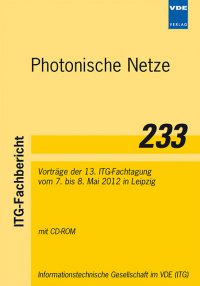Quality metrics for advanced modulation formats in optical communications: OSNR, Q-factor, EVM, and BER
Conference: Photonische Netze - 13. ITG-Fachtagung
05/07/2012 - 05/08/2012 at Leipzig, Germany
Proceedings: Photonische Netze
Pages: 5Language: englishTyp: PDF
Personal VDE Members are entitled to a 10% discount on this title
Authors:
Schmogrow, R.; Hillerkuss, D.; Koos, C.; Freude, W.; Leuthold, J. (Karlsruhe Institute of Technology (KIT), Karlsruhe, Germany)
Nebendahl, B. (Agilent Technologies, Boeblingen, Germany)
Abstract:
Measuring the quality of optical signals is one of the most important tasks in optical communications in order to characterize optical channels and networks. A variety of metrics are available, namely the general shape of the eye diagram, the optical signal-to-noise power ratio (OSNR), the Q-factor as a measure of the eye opening, the error vector magnitude (EVM), and the bit error ratio (BER). Some of these metrics can be applied to any modulation format alike (e. g. OSNR, BER), other metrics are specifically suited for certain formats. Simple formats like on-off keyed signals can be evaluated by the eye-diagram or the Q-factor, but more advanced modulation formats such as quadrature amplitude modulation (QAM) call for a different metric. In wireless and wireline communications, EVM is well established to give a reliable estimate of the signal quality of QAM signals. While the BER is the most conclusive quality determinant, it is sometimes difficult and often time consuming to measure, especially in the context of multi-carrier experiments. This is an issue in laboratory experiments, where so far most QAM receivers employ offline digital signal processing at much reduced clock rates. This offline processing makes it very time consuming to reliably compute the BER, especially for high signal qualities. As a consequence, a faster — yet reliable — performance measure is needed.


